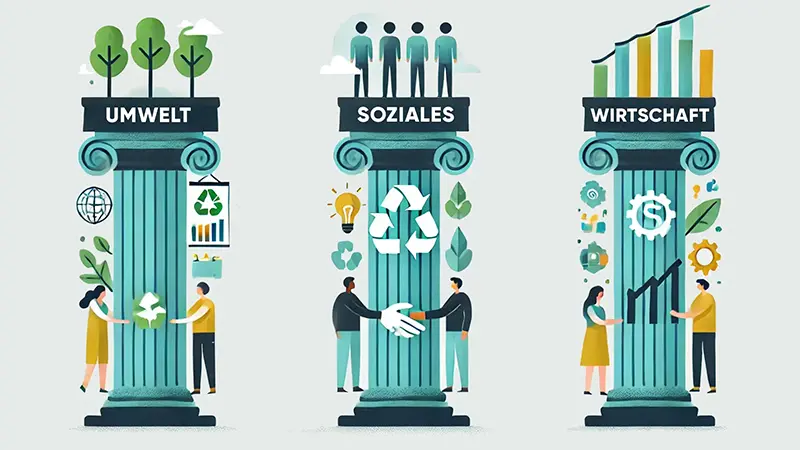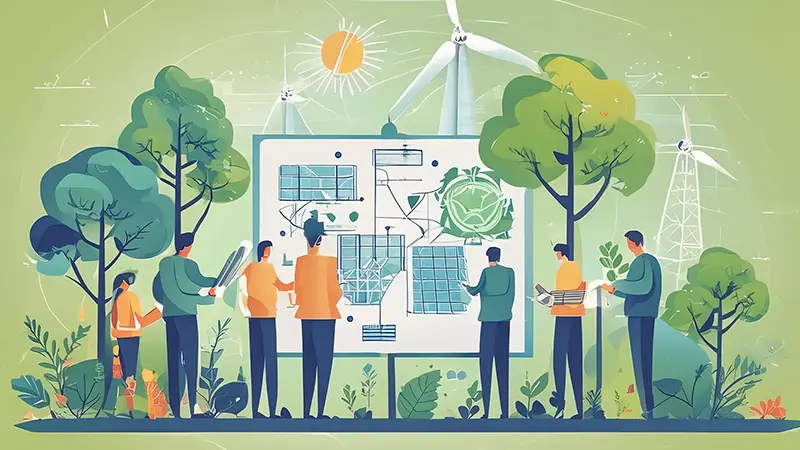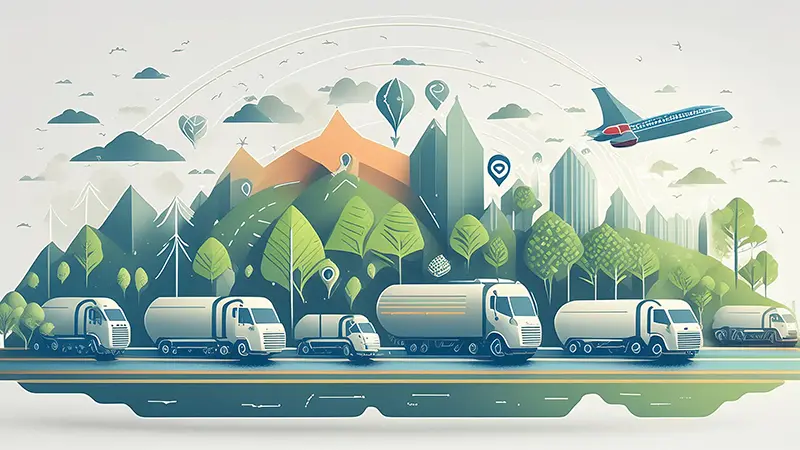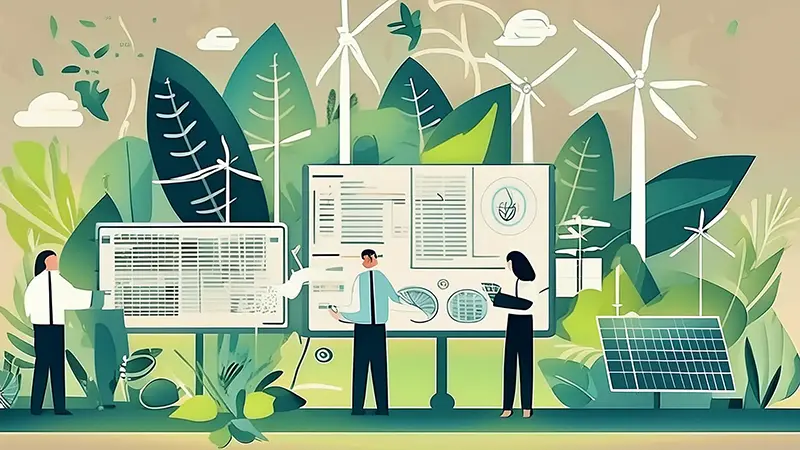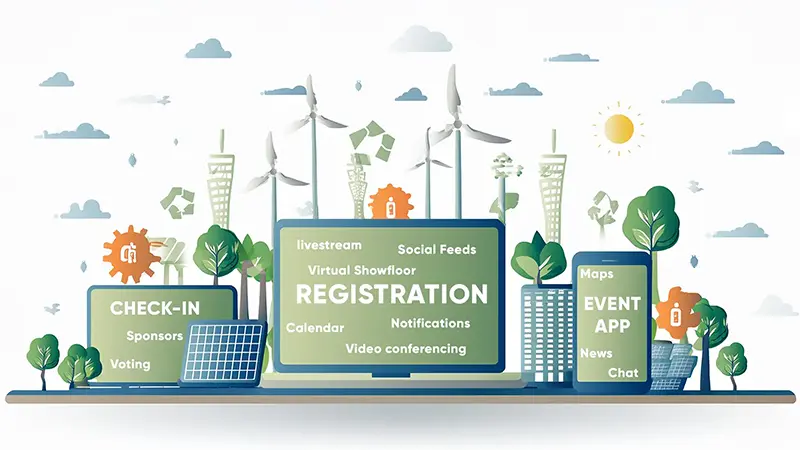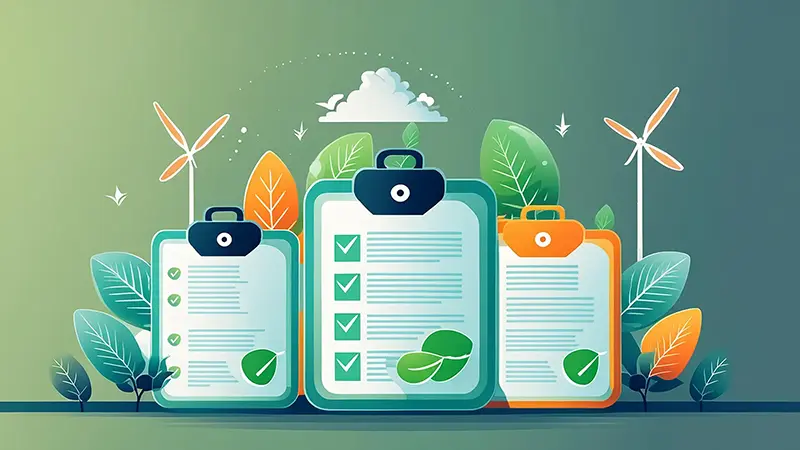Sustainable events are more than just a passing trend – they are a necessary step towards responsible and future-oriented event planning. Environmental awareness and resource conservation are playing an increasingly important role in today’s world. It is therefore essential that events also try to follow these principles. Our blog post is intended to help you create a strategy for designing sustainable events. Find out how you can not only protect the environment through targeted measures, but also save costs and improve your image and that of your events.
The relevance of sustainable events
Why is a sustainable event strategy so important today? Due to the increasing environmental problems and scarcity of resources, sustainability is becoming increasingly important in all areas of life – including the planning and implementation of events. The “Fridays For Future” movement in particular has raised awareness of this. A sustainable event strategy offers you numerous advantages. The reasons for striving for sustainability are therefore manifold and include
-
Umweltschutz
By reducing waste, energy consumption and CO2 emissions, sustainable events make an active contribution to environmental protection.
-
Cost efficiency
Sustainable events can often save costs in the long term, for example by using reusable materials and reducing waste.
-
Image and reputation
Companies and event organizers that are committed to sustainability improve their image and reputation with customers, partners and the public.
-
Regulatory requirements
Many countries and regions are tightening their environmental regulations, and sustainable practices help to meet these requirements or at least be prepared.
-
Social pressure
The public and participants increasingly expect sustainable practices, and an event that meets these expectations can achieve higher participant satisfaction and retention.
What is sustainability at events?
Definition
Sustainability refers to the development and realization of strategies and measures that promote the long-term protection and preservation of our natural resources. In the context of events, this means planning and implementing events in such a way that negative impacts on the environment are minimized and positive social and economic effects are maximized.
To ensure that sustainable practices in event planning are applied consistently and effectively worldwide, there is the ISO 20121 standard. This international standard specifies requirements for a sustainability management system for events and helps you to systematically achieve and measure your sustainability goals.
Three pillars of sustainability
Sustainability is based on three central pillars: environmental, social and economic. Each of these pillars plays an important role in the planning and implementation of sustainable events and helps to ensure that events are both sustainable and successful.
-
Environment
Environmental sustainability focuses on the protection of natural resources and the reduction of environmental pollution. For events, this means taking measures to minimize waste, energy consumption and CO2 emissions.
-
Social affairs
Social sustainability aims to promote social justice and inclusion. In the event context, this means designing events in such a way that they are accessible to everyone and take into account the needs of different groups of participants.
-
Economy
Economic sustainability refers to the creation of economic added value and the support of local economies. In event planning, this means managing costs effectively and making economically viable long-term decisions.
By considering these three pillars of sustainability and integrating them into your event strategy, you can ensure that your events are not only environmentally and socially responsible, but also economically successful and sustainable.
Focal points for sustainable events
In the following sections, we take a closer look at the individual focal points of the pillars and provide you with methods for realizing them in practice. Of course, it is difficult to realize all points. But every measure contributes to the goal of realizing sustainable events. In addition, communicating the realization of these points can give you a relevant push in marketing.
1. planning and preparation
1.1 Sustainable event venues
Choosing the right location is a crucial step in planning sustainable events. Environmentally friendly venues are another way of minimizing the ecological footprint of an event and achieving your sustainability goals.
Our tips for sustainable event venues:
-
Focus on sustainability
When selecting venues, make sure that they have already implemented measures to promote sustainability. Many venues and hotels have recognized the importance of being environmentally friendly and are adopting sustainable practices.
-
Environmentally friendly measures
Find out about the sustainability strategies of potential venues. These include energy efficiency, waste management and the use of renewable energies. Ask what specific sustainable measures are being taken by the location.
-
Certifications and environmental labels
Another important criterion when choosing a location is certification with environmental labels. These certifications, such as ISO 14001 or the EU Ecolabel, confirm that the venue adheres to strict environmental standards and is continuously working to improve its ecological performance.
-
Cooperation with sustainable service providers
Check whether the location works with other environmentally friendly service providers, such as caterers who use regional and seasonal products, or technology companies that rely on energy-efficient solutions.
1.2 Environmentally friendly materials
By choosing recyclable and reusable materials, you can significantly reduce the ecological footprint of your events while promoting an environmentally conscious image.
Our tips for using environmentally friendly materials:
-
Recyclable materials
Use materials that can be easily recycled, such as paper, cardboard, glass and certain plastics. Recycled paper and environmentally friendly printing inks should be used for printed materials such as flyers, posters and programs.
-
Reusable equipment
Opt for reusable decorations and equipment. Instead of using disposable products, many event accessories such as tablecloths, tableware and decorative elements can be used several times. This not only saves resources, but also reduces waste.
-
Natural and biodegradable materials
Use materials that are biodegradable and leave no harmful residues. Natural fabrics such as cotton, jute and bamboo are excellent alternatives to synthetic materials.
-
Loan and rental services
Use rental and hire services for event equipment to avoid buying disposable products. Many companies offer sustainable event solutions that include environmentally friendly materials and reusable products.
-
Creative and innovative solutions
Be creative in your choice of materials. Upcycling projects, in which new decorations and furnishings are created from old materials, are not only environmentally friendly, but also unique and appealing.
1.3 Energy efficiency
By taking targeted measures to reduce energy consumption, you can not only save costs, but also take a further step towards achieving your sustainability goals.
Our tips for reducing energy consumption:
-
Efficient LED lighting
The use of LED lights can significantly reduce energy consumption. LEDs consume less electricity and have a longer service life, which also reduces costs in the long term.
-
Renewable energy sources
Make sure that the electricity and heat for your event come from renewable energy sources, such as solar, wind or hydroelectric power. Many venues now offer the option of covering their energy requirements from sustainable sources.
-
Efficient technology
Choose technology with a high energy efficiency class. This applies to all technical equipment used at your event, including music systems, cooling systems and lighting. Efficient technology consumes less energy and therefore contributes to sustainability.
-
Positive energy management
An efficient energy concept should be an important criterion when selecting venues. Ask how the venue manages its energy consumption and whether energy-saving measures have been implemented. Venues that actively work to reduce their energy consumption are a good choice for sustainable events.
-
Conscious user behavior
Sensitize your team and your participants to a conscious use of energy. This can be achieved by simple measures such as switching off appliances and lighting when not in use or using natural light sources.
2. transportation and logistics
2.1 Reduction of CO2 emissions
The arrival and departure of participants is often the biggest source of emissions at events. According to meetgreen.com, 80% of an event’s emissions are caused by traveling by plane or car. Accordingly, this focus should be given special priority for sustainable events. Here are some measures that can help to reduce CO2 emissions.
Our tips for environmentally conscious mobility
-
Public transportation
Encourage participants to use public transportation. This can be supported by cooperations with local transport companies that provide discounted tickets or special offers for event participants. Information and incentives to use public transport can be communicated in advance via an event app.
-
Carpooling
Encourage carpooling to reduce the number of vehicles driving to the venue. This can also be organized via an event app in which participants can offer and search for carpooling opportunities.
-
Shuttle services & cooperation with transport services
Offer shuttle services or other transportation services from the nearest train station or central points. Ideally, these vehicles should be powered by low-emission vehicles such as hybrids or electric cars.
-
Incentives for environmentally friendly travel
Reward participants who choose environmentally friendly travel options, for example with discounts on admission tickets or small gifts. This can increase the willingness to switch to environmentally friendly means of transportation.
-
Virtual participation
Eliminate travel emissions completely by allowing people to attend the event virtually. More information on this will follow in the "Event formats" section.
2.2 Local suppliers
Working with local suppliers at sustainable events has many advantages. In addition to shortening transportation routes, it also strengthens the local economy and triggers positive social effects at the same time.
Our tips for integrating local suppliers:
-
Research and network building
Look for local suppliers and build up a network of trustworthy suppliers. Visit local markets, trade fairs and events to get to know potential partners.
-
Long-term partnerships
Develop long-term partnerships with local suppliers. This can lead to better conditions, greater reliability and stronger cooperation.
-
Promotion and communication
Communicate openly about your decision to use local suppliers and actively promote their products at your event. This can be done through special labeling, information stands or integration into event marketing.
3. food and catering
3.1 Regional and seasonal products
Using regional and seasonal food not only significantly reduces your ecological footprint, but also supports the local economy. On top of that, you can better ensure the freshness and quality of the goods by being close to the retailer.
Our tips for integrating regional & seasonal products:
-
Selection of caterers
When selecting catering companies, pay attention to their ecological footprint and certifications. Check which of the companies offer regional products and how sustainable their practices are.
-
Certifications and labels
If no regional suppliers are available, you can fall back on certified products with sustainability labels such as Demeter. These labels guarantee a certain degree of ecological and sustainable action.
-
Communication and transparency
Inform your participants about the use of regional and seasonal products. This can be done through menu descriptions, information stands or during the event. Transparency creates trust and demonstrates your commitment to sustainability. On top of this, the use of regional and seasonal products for your events can be an important unique selling point.
3.2 Avoiding food waste
With targeted strategies to minimize waste, event organizers can not only save costs, but also make an important contribution to environmental protection.
Our tips for minimizing waste:
-
Precise planning
Careful planning of the required quantities of food is essential to avoid overproduction and waste. Use empirical values and analyses of past events to calculate requirements as accurately as possible.
-
Flexible menus
Plan flexible menus that can be adapted to the actual number of participants. This makes it possible to make changes at short notice and reduce surpluses.
-
Adjust portion sizes
Make sure that the portion sizes correspond to the needs of the participants. Smaller portions can help to ensure that less food is left on plates and ultimately ends up in the bin.
-
Donations of surplus food
Work with local organizations and food banks to donate surplus food. This not only helps to avoid food waste, but also supports people in need in the region.
-
Education and awareness-raising
Inform your participants and catering staff about the importance of avoiding food waste. Make them aware of how to handle food consciously and minimize waste.
3.3 Sustainable packaging
By choosing biodegradable or reusable packaging, you can reduce waste and promote environmentally friendly alternatives at the same time. This reduces plastic waste, conserves resources and improves your image and that of your sustainable event!
Our tips for choosing and using sustainable packaging:
-
Biodegradable packaging
Opt for packaging that is completely biodegradable. These often consist of materials such as starch, cellulose or bagasse (sugar cane fibers) and decompose quickly in nature without leaving any harmful residues.
-
Reusable packaging
Wherever possible, reusable packaging should be preferred. These can be, for example, reusable cups, dishes and containers that can be cleaned and reused after the event.
-
Recycled materials
Use packaging made from recycled materials. This not only conserves resources, but also supports the recycling cycle. Some recycled products also have patterns that radiate a unique charm thanks to the processing.
-
Avoiding single-use plastic
Avoid single-use plastic products as far as possible and offer environmentally friendly alternatives instead, such as paper bags, cloth bags or compostable plastic alternatives.
4. communication and marketing
4.1 Transparent communication
Transparent communication about the sustainability efforts of your event helps to raise awareness and commitment among participants and stakeholders. Through open and honest communication, you can create trust and raise awareness of your sustainable events.
Our tips for transparent communication:
-
Green communication
Use your communication channels to actively promote the topic of sustainability. For example, for every event registration you could make a donation to an environmentally conscious project that aims to achieve ecological balance. This shows your commitment and motivates the participants to also work towards sustainability.
-
Disclosure of the measures
Inform your participants and stakeholders in detail about the specific measures you are taking to make your event sustainable. This includes aspects such as environmentally friendly venues, sustainable materials, energy efficiency, transportation options and catering.
-
Transparent reporting
Create a sustainability report after the event that documents the measures implemented and their results. Share this report openly with your participants and stakeholders to ensure transparency and highlight your successes and areas for improvement.
-
Obtain feedback
Ask your participants for feedback on the sustainability efforts of your event. This can give you valuable insights into how your measures are perceived and where there is still room for improvement.
-
Partnerships and certifications
Work with recognized partners and organizations that can support and certify your sustainability efforts. This gives your measures additional credibility and shows that you are guided by high standards.
4.2 Digital alternatives
By using digital invitations and programs at sustainable events, you can not only avoid waste, but also make communication more efficient. Another advantage is not only the easy updating of information, but also the increased reach of these communication channels.
Our tips for digital alternatives:
-
Minimization of print media
If print media is unavoidable, use recycled material or FSC-certified paper that can also be printed on both sides. This reduces paper consumption and supports sustainable forestry.
-
Digital invitations
Send invitations by e-mail or via social media instead of printed cards. This not only saves paper, but also enables faster and more cost-effective distribution.
-
Online programs and materials
Make programs, presentations and other event documents available digitally. These can be published on the event website or in an event app and easily updated.
-
Event app
An event app is ideal for providing all important information centrally. Participants can access programs, news and notifications directly via the app. Content can also be made available on site using a QR code, without the need for print media. You can find out more about this in the article below.
5. waste management
5.1 Recycling stations
Setting up clearly marked recycling stations at sustainable events for different types of waste helps to reduce waste and reuse valuable resources. Such measures also promote the environmental awareness of your participants.
Our tips for setting up recycling stations:
-
Clear labeling
Make sure that all recycling stations are clearly visible and clearly marked. Use color-coded containers and clear labeling to distinguish the different types of waste.
-
Strategic placement
Place the recycling stations in central and highly frequented locations, such as entrances, catering areas and meeting places. This facilitates access and increases usage.
-
Information and education
Inform the participants about the recycling stations and their importance. Use signs, announcements and digital communication tools to instruct participants to separate waste correctly.
5.2 Waste avoidance
By reducing single-use products and promoting reusable options, you can significantly minimize waste at your events and make a positive contribution to environmental protection at the same time. This not only saves you money on purchasing, but also reduces the cost of disposal.
Our tips for avoiding waste:
-
Dispensing with single-use plastic
As with sustainable packaging, we recommend avoiding the use of single-use plastic products such as cutlery, plates, cups and straws. Instead, opt for reusable or compostable alternatives.
-
Reusable cups and tableware
Use reusable cups and tableware that can be cleaned and reused after use. Or offer participants incentives to bring their own reusable cups, for example by offering discounts on drinks.
-
Refill stations
Provide water and drink stations where participants can refill their own bottles and cups. This reduces the need for disposable products. On top of that, refill stations are a great place for networking.
-
Reusable decoration
Merhweg can also apply to decorative elements. Invest in high-quality and timeless decorations that can be used for multiple events.
-
Promoting waste awareness
Make your participants aware of the importance of waste prevention. Inform them about the measures you have taken and encourage them to actively contribute to waste prevention themselves.
6. social responsibility
6.1 Ethics & inclusion
In line with the three pillars, social issues are also an important component of sustainable events. By taking targeted measures, you can ensure that your events are accessible and fair for everyone.
Our tips for inclusion:
-
Accessibility
Make sure that your event is barrier-free. This includes access to venues, the provision of wheelchair-accessible facilities, disabled toilets and special seating. Digital accessibility is also important, e.g. through an easy-to-read event app and alternative display methods.
-
Equality and diversity
Encourage the participation of diverse groups by creating an inclusive and respectful atmosphere. This includes selecting speakers and artists from different cultural and social backgrounds and ensuring that all participants have equal access to information and resources.
6.2 Local communities
By actively involving local communities, events can not only be made more sustainable, but also more socially responsible. Parts of this focus can be found in the tips already mentioned, but this only reinforces their importance. You will be surprised how much support you receive from the local community when you approach them.
Our tips for supporting the local community:
-
Cooperation with local service providers
Use local service providers and suppliers for catering, decoration, technology and other event services.
-
Promoting local talent
Integrate local artists, musicians and speakers into your event. This promotes cultural diversity and gives local talents a platform to present themselves.
-
Non-profit partnerships
Work with local non-profit organizations and support their work. This can be done through donations, joint campaigns or the provision of resources.
-
Volunteering and commitment
Allow members of the local community to volunteer at your event. This promotes a sense of community and provides valuable support for the event.
-
Sustainable event venues
Choose venues that actively support the local community and sustainability. Many locations have programs to support local initiatives and focus on environmentally friendly practices.
-
Education and enlightenment
Use your sustainable event to inform participants about the local culture, history and environment. Offer workshops, guided tours or information stands that raise awareness of local issues.
7. success measurement and follow-up
7.1 Feedback and improvement
If you stop getting better, you will also stop being good. Accordingly, it should be your constant concern to obtain feedback and identify optimization potential. In addition to your own improvement, such measures also promote engagement with your participants and stakeholders. At the same time, the will to self-optimization and willingness to learn sends a strong signal.
Methods for obtaining feedback:
-
Surveys
Use online surveys or digital questionnaires via an event app to collect targeted feedback on various aspects of your event. Ask for the participants' perceptions, experiences and suggestions for improvement.
-
Direct conversations
Talk directly to the participants to get immediate feedback. This can take the form of short interviews, informal discussions or a feedback stand during the event.
-
Social media
Use social media to collect feedback from participants. Encourage them to share their experiences and suggestions in comments or posts.
-
Set feedback impulses
Use incentives to encourage people to share their opinions. For example, combine a competition with participation in surveys or interviews.
7.2 Sustainability report
Such a report not only helps to analyze the successes and challenges of an event, but also strengthens the confidence of participants and stakeholders in your efforts for sustainable events.
Contents of a sustainability report
-
Goals and measures
Describe the sustainability goals you have set for your event and the measures taken to achieve them.
-
Results and effects
Analyze the results of your measures and their impact on the environment, society and the economy. Use concrete data and figures to prove your success.
-
Challenges and improvements
Describe the challenges you encountered and how you overcame them. Show what improvements you are planning for future events.
-
Stakeholder feedback
Integrate feedback from participants and other stakeholders into the report. This shows that you value their opinions and include them in your planning.
-
Future prospects
Outline the next steps and long-term plans for the sustainability of your future events.
8. event formats
Innovative formats such as hybrid and virtual events offer numerous advantages and help to drastically reduce the ecological footprint, cut costs and increase flexibility for participants.
8.1 Virtual events
Virtual events are completely digital and offer numerous opportunities to hold a sustainable event. Not only do they avoid any emissions and travel costs for participants, they also offer numerous other advantages. You can find out more about this in our use case on virtual events.
-
No travel expenses
As all participants join online, all travel expenses and the associated emissions are completely eliminated. This is particularly advantageous for international events.
-
Simple scalability
Virtual events can be easily scaled to reach a large number of participants without the logistical challenges of a physical event.
-
Cost reduction
The costs for venues, catering and other physical resources are eliminated, making virtual events significantly more cost-effective.
-
Interactive possibilities
Use digital tools and platforms to create interactive and engaging experiences. Functions such as live surveys, Q&A sessions and networking rooms can actively involve participants and enrich the event.
-
Recordings and renditions
Virtual events can be easily recorded and replayed later, keeping the content accessible to a wider audience and allowing it to be used for longer.
8.2 Hybrid events
Hybrid events take place both on site and digitally. They combine the advantages of virtual and live events and offer participants the opportunity to attend either digitally or on site. Depending on the nature of your event, this can be an ideal compromise to make events more sustainable. Find out more in our use case on hybrid events.
-
Flexibility
Participants are free to decide whether they want to be physically or virtually present. This increases the reach and accessibility of the event.
-
Reduction of travel costs and emissions
The option of digital participation significantly reduces travel costs and the associated CO2 emissions. This makes the event more sustainable and environmentally friendly.
-
Cost efficiency
The costs for catering, accommodation and other logistical projects are reduced due to the lower number of participants physically present. This saves resources and reduces the overall costs of the event.
-
Innovation and image
Hybrid events demonstrate innovative ability and future-oriented thinking. Communicate these aspects actively to strengthen your image.
Sustainable events with the help of digital tools
By using modern technologies, you can reduce the ecological footprint of your events, make processes more efficient and at the same time increase the comfort and satisfaction of participants. This already happens during the initial communication, such as registration, at check-in or during and after the event with the help of an event app. We would now like to briefly discuss the three points mentioned in more detail.
Registration & Guest Management
Digital solutions for the registration and admission process optimize your workflows and at the same time are able to avoid emissions.
-
Paperless administration
The use of digital registration forms and guest lists eliminates the need for printed materials. This not only saves paper, but also the resources that would be required to print and transport the materials.
-
Efficient data acquisition
Digital registration systems enable participants' data to be recorded quickly and accurately. This reduces errors and makes it easier to manage and analyze the information. It also offers the possibility of recording specific data. Compile complex questionnaires with conditions to collect information for catering or hotel accommodation. Such information helps, for example, to plan resources efficiently.
-
Real-time updates
Digital solutions allow you to update and customize the guest list in real time. This is particularly useful if registrations or participant details change at short notice.
-
Personalized communication
Digital registration systems enable personalized communication with participants. Automatic confirmation e-mails, reminders and individual updates can be sent easily, which increases satisfaction.
Digital admission management
Optimize your check-in with the help of digital technologies. Such solutions reduce waiting times, simplify admission management and reduce potential emissions from your events.
-
Fast entry
Digital tickets and QR codes enable a fast and smooth admission process. Participants can show their tickets on mobile devices, which speeds up check-in and avoids long queues.
-
Contactless and safe
Especially in times of health and safety concerns, digital admission management offers a contactless alternative to traditional admission methods. This increases safety for everyone involved.
-
Reduction of paper
By dispensing with printed tickets and using digital alternatives, paper consumption is significantly reduced, which contributes to a more sustainable event. If you still prefer badges, there is a wide range of badges made from environmentally friendly materials.
-
Real-time overview
You receive a real-time overview of the number of guests checked in. This simplifies administration and enables better planning and adaptation to local conditions.
-
Data analysis and reporting
Digital admission systems offer comprehensive analysis tools that provide valuable insights into attendee behavior and event dynamics. This data can be used to optimize future events in the long term.
Event App
Similar to the registration process, an event app helps to improve the flow of information and reduce the ecological footprint of the event. In addition, these digital event companions open up new opportunities to communicate and interact with participants.
-
Reduction of paper consumption
By providing programs, agendas, maps and other important information in digital form, you can eliminate the need for printed materials. This saves paper, printing and delivery costs and reduces potential waste at the same time.
-
Aktualisierungen in Echtzeit
With an event app, you can inform participants in real time about changes to the program, new information and important announcements. This increases the flexibility and responsiveness of your event.
-
Interactive functions
An event app offers numerous interactive features, such as live polls, Q&A sessions, and feedback forms that encourage attendee engagement and provide valuable insights.
-
Network possibilities
Participants can use the event app to network with each other, exchange contact information and arrange meetings. This promotes networking and interaction with one another.
-
Personalized experiences
By integrating personalized content and functions, you can offer participants an individual experience. This can be done through personalized agendas, reminders and special offers.
-
Live Support
Support participants with questions or problems with a live chat or support channel that can be accessed directly and at any time via the app.
Helpful documents for sustainable events
To facilitate the planning and implementation of sustainable events, we would like to provide you with some helpful documents and tools. The following resources provide you with valuable information, checklists and tools to help you achieve your sustainability goals.
CO2 calculator of the Federal Environment Agency
The Federal Environment Agency’s CO2 calculator is a useful tool for calculating the CO2 emissions of your event and identifying ways to reduce them. The calculator takes into account various aspects such as participants’ travel, energy consumption and catering. Use the calculator to create a sound basis for your sustainability measures.
Guidelines for the sustainable organization of events
The Federal Ministry for the Environment, Nature Conservation, Nuclear Safety and Consumer Protection (BMUV) offers comprehensive guidelines for the sustainable organization of events. This guide contains practical tips and recommendations on how you can integrate sustainability principles into all phases of event planning.
Checklist of the BMUV
The BMUV offers a comprehensive checklist for detailed planning and realization. This interactive checklist covers a wide range of aspects that should be considered when organizing sustainable events. It is a valuable tool to ensure that no important points are overlooked.
Our quick checklist
For quicker and easier planning, we offer a shorter checklist that summarizes the most important points. This checklist is ideal for smaller events or as an initial guide for sustainable events.
Download our PDF checklist for sustainable events now!
Conclusion
The realization of a sustainable event strategy requires planning, commitment and the willingness to break new ground. With the right measures and a clear focus on the environment, social issues and the economy, you can create events that are not only impressive, but also make a positive contribution to sustainability. Use the tips and resources presented here to organize your events in a future-oriented and responsible way. Because sustainable events are not only good for the environment – they are also good for your image and your long-term chances of success.
You might also be interested in

Find out how event apps help companies to organise events more efficiently, sustainably and interactively – digitally and smartly.

Optimise automotive events with an event app – digital, efficient, interactive. The solution for modern automotive events.


